Exciting times lie ahead in the realm of space technology, heavy lift rocket development reminiscent of the era witnessed in the 1960s when the United States and the Soviet – USSR engaged in a fierce competition to land on the moon. However, there is a notable distinction this time around: the competition is not between nations but centers around one visionary individual, Elon Musk, and multiple countries, including the USA. This remarkable shift is driven by Elon Musk’s grand vision and commitment to developing a Saturn V-class rocket, ushering humanity into a new era of exploration that extends beyond the Moon and Mars. (CAUTION: This is a lengthy article – Please find sufficient time to get to the flow!)
Meet Starship: A brand new rocket, nothing like others in market.
SpaceX’s Starship is a fully reusable heavy lift rocket from SpaceX designed for a variety of missions, including crewed space travel, cargo transport, lunar missions, and even interplanetary missions like Mars colonization. It is part of Elon Musk’s vision to make space travel more affordable and accessible. This project is real and has achieved critical stage in development process with first full scale prototype test launch on 20th April 2023. Second prototype is on launch pad waiting for launch license approval from FAA. Even as I write this article many more prototypes are being built and along with main engines called Raptor 2.
Key features and goals of SpaceX’s Starship include:
Reusability: Starship is designed to be fully reusable, meaning it can be launched, landed, and relaunched multiple times. This reusability is intended to significantly reduce the cost of space travel.
Versatility: Starship is intended to be a versatile spacecraft capable of carrying both crew and cargo. It can accommodate a large number of passengers or carry a variety of payloads. There will be many variations of Starship for all types of payloads to Space.
Interplanetary Travel: SpaceX envisions using Starship for interplanetary missions, including crewed missions to Mars and beyond. Its large payload capacity and potential for long-duration missions make it a candidate for deep space exploration.
Lunar Missions: Starship is intended to play a role in NASA’s Artemis program, which aims to return humans to the Moon. SpaceX has proposed using Starship as a lunar lander for astronauts. SpaceX has a contract from NASA for lunar lander demonstration.
High Payload Capacity: Starship is designed to have a high payload capacity, allowing it to carry a wide range of cargo, satellites, and scientific instruments into space.
Rapid Turnaround: SpaceX’s goal with Starship is to achieve rapid turnaround times between launches, making it possible to conduct frequent space missions.
Following video shows first launch test flight Starship rocket on April, 20, 2023.
Starship rocket is not just a concept; it’s a tangible reality. It represents a giant leap in space technology, designed for a wide range of missions, from lunar landings to interplanetary travel. What sets Starship apart is its reusability, potentially revolutionizing space exploration by significantly reducing the cost of reaching orbit. With its impressive payload capacity and ambitious goals of carrying humans to Mars, Starship has garnered global attention and holds the promise of shaping the future of space travel. In a recent test launch, all thirty-three of its powerful Raptor engines were successfully ignited simultaneously, propelling the spacecraft clear of its launch tower. However, during the later stages of the flight, multiple engine failures occurred, necessitating the activation of the flight termination systems. Nevertheless, the anticipation for a second test flight scheduled for as early as in October 2023, is palpable. It’s becoming increasingly evident that the Starship’s design is steadily advancing towards a successful orbital flight. As the developmental flights progress, the world will soon find itself confronted with the exciting challenges and opportunities presented by this groundbreaking spacecraft. “Starship is for real! India will have to wake up to that reality.” This is something being ignored by India and all other space agencies around the world, except probably by China.
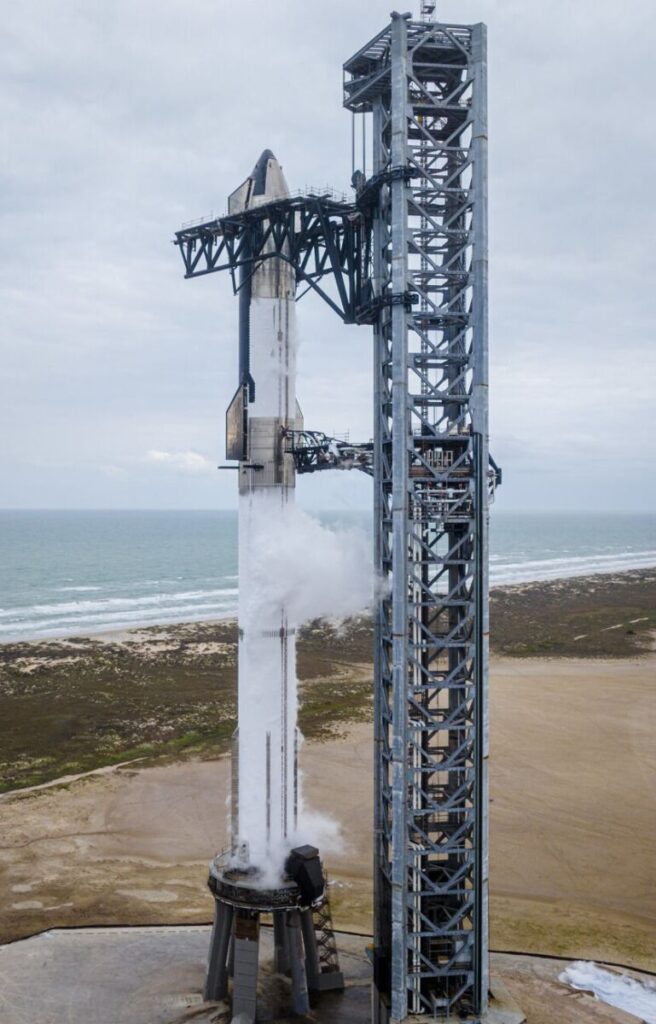
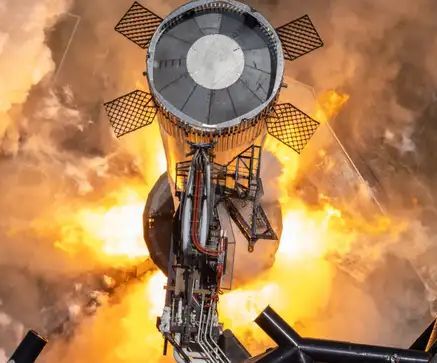

Artistic view of Moon Version of Starship - Lunar Lander Starship.
"Starship is for real! India will have to wake up to that reality."
This statement underscores the significance and tangible nature of the Starship project, being pursued by SpaceX. Starship is a cutting-edge spacecraft designed for ambitious missions, including interplanetary travel and colonization. The phrase “is for real“ emphasizes that this isn’t just a concept or an idea; it’s an actual project that’s in development and testing stages, some thing which the whole world is ignoring, due to GETTING USED TO phenomena.
The second part of the statement, “India will have to wake up to that reality,” suggests that India, as a nation actively involved in space exploration and technology, needs to take notice of the developments surrounding Starship. It implies that India should recognize the potential impact and opportunities presented by this emerging technology. Our current rocket technologies PSLV, GSLV, LVM3 are destined to become obsolete in the face of Starship, owing to its remarkable advantages in pricing, accessibility, flexibility, and cargo capacity. Perhaps the most remarkable of these advantages is the pricing factor, specifically the cost per kilogram to reach orbit. Elon Musk has quoted a price as low as 10 million dollars per launch!
Brief History of Starship Rocket
Origins and SpaceX’s Vision (Early 2000s): Elon Musk always had a grand vision of making space travel more affordable and enabling the colonization of other planets. In pursuit of his vision, he even ventured to Russia, where his ideas were riduculed. He ended up starting SpaceX company in 2002 to try it out himself. The idea of a fully reusable spacecraft, capable of traveling to Mars and beyond, began to take shape.
Falcon 1 and Falcon 9 (2006-2018): SpaceX developed and successfully launched a series of rockets, including Falcon 1 and Falcon 9, which were partially reusable. These rockets proved SpaceX’s capability to reduce the cost of reaching space by reusing components.
- Heavy lift vehicle concept (2015-16): Mars Colonial Transport MCT, a heavy lift vehicle concept was announced by Elon Musk in 2015 as series of rockets, including Falcon 9, which were partially reusable. These rockets proved SpaceX’s capability to reduce the cost of reaching space by reusing components.
Starship Announcement (2016): In September 2016, Elon Musk unveiled SpaceX’s plans for a fully reusable spacecraft system called “Interplanetary Transport System” or “BFR” (Big Falcon Rocket). This ambitious project aimed to revolutionize space travel by making it more accessible and cost-effective.
Name Change to Starship (2018): The project’s name changed from BFR to Starship and Super Heavy in 2018. Starship refers to the spacecraft, while Super Heavy is the massive first-stage booster.
Starship Development (2018-Present): Development of Starship and Super Heavy has been ongoing with several prototype iterations. These prototypes, starting with the Starship Hopper, gradually increased in size and complexity. SpaceX conducted numerous tests, including static fires, short flights, and high-altitude tests.
SN1 and SN2 Prototypes (2020): The SN1 and SN2 (Serial Number) prototypes were the first full-scale Starship prototypes. They aimed to test the structural integrity and assembly processes.
Starship SN3 and Beyond (2020): Further iterations followed, with SN3 being the next notable prototype. Each new version addressed design and structural improvements.
Starship SN8 – High-Altitude Test (December 2020): SN8 marked a significant milestone with its high-altitude test flight. It was the first Starship prototype to reach a high altitude, perform a “belly flop” maneuver, and attempt a landing. Although it experienced a hard landing and explosion, it demonstrated many key capabilities.
- Further Development (till 2023): SpaceX continued its iterative development with SN9, SN10, SN11, and more. Each prototype incorporated lessons learned from previous tests.
First Integrated Prototype Test (2023-Present): SpaceX managed to fly a fully integrated Starship rocket first time in Apr, 20, 2023. This prototype reached an altitude of around 39 Kms.
Second Integrated Prototype Test (2023-Present): Starship prototype is fully stacked and ready for launch on Starbase launch tower, waiting for launch approval from FAA.

Starhopper En route to launch pad

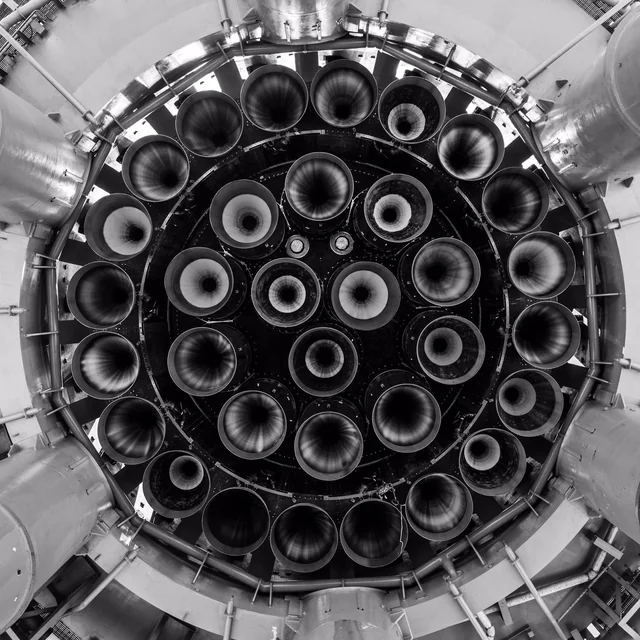
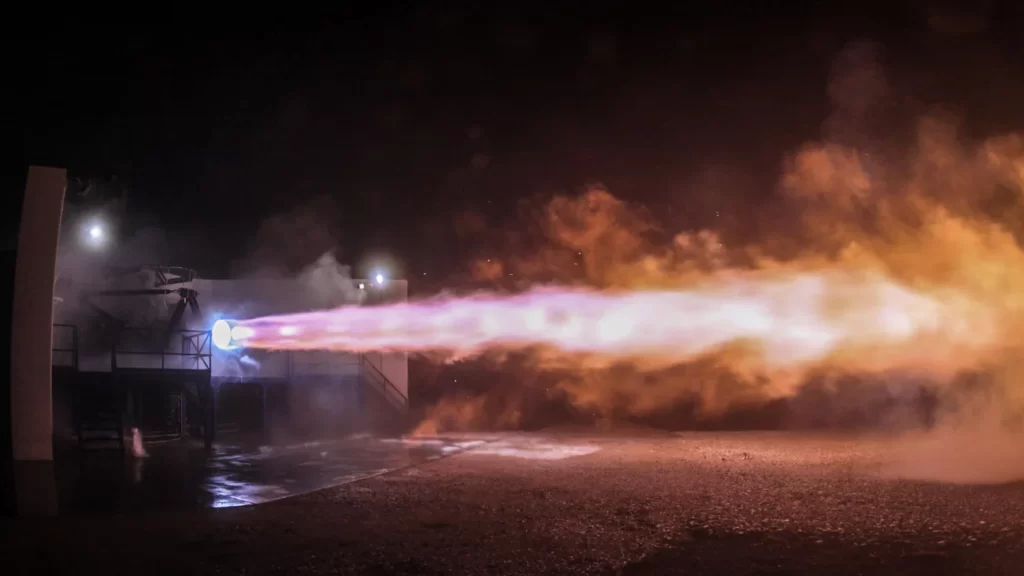
Raptor Engine undergoing validation testing at SpaceX facility.

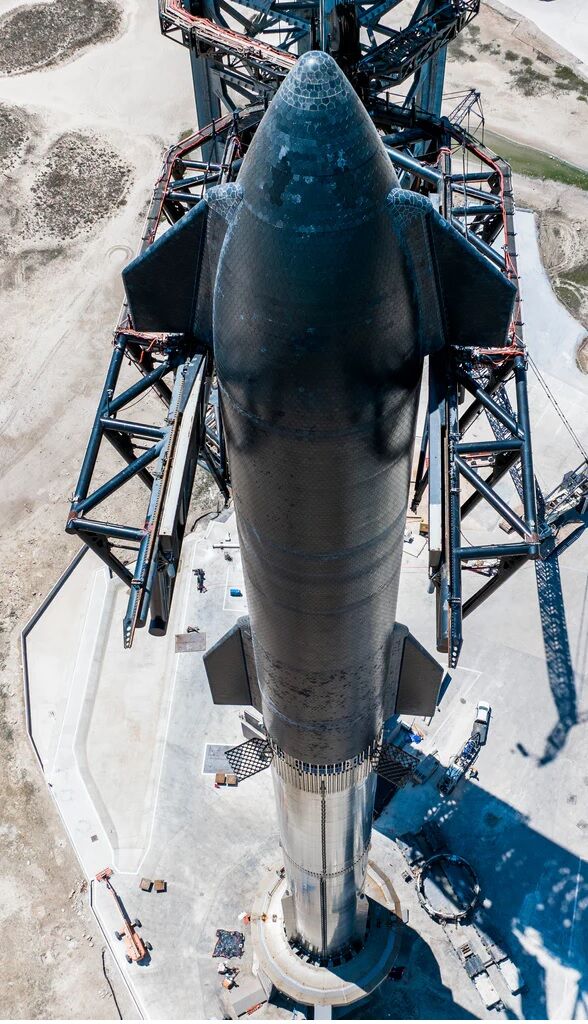
Milestone- 2023!
In 2023, a significant milestone was reached with the first orbital test flight of Starship on April 20th. Unfortunately, this prototype met a dramatic end, disintegrating less than four minutes after liftoff. The mission had ambitious goals, including nearly completing a full orbit around Earth, performing a controlled reentry into the atmosphere, and splashing down near Hawaii in the Pacific Ocean.
During this historic flight, Starship achieved a remarkable feat by breaking the record for the most powerful rocket stage ever launched, a record that had been held for five decades by the Soviet N1 rocket. At precisely 08:33 CDT (13:33 UTC), the spacecraft successfully lifted off, soaring past the launch tower. However, within just 85 seconds of liftoff, SpaceX encountered a major setback as the 13 central engines lost thrust vector control, rendering the rocket uncontrollable. As a result, the vehicle ascended to an altitude of approximately 39 kilometers (24 miles) before losing altitude and entering a perilous spin. Vehicle had passed Max Q test proving structural design of the rocket. In response to this critical situation, the autonomous flight termination system was activated, leading to the vehicle’s destruction a mere 40 seconds later.
Despite the mission’s unfortunate conclusion, it’s crucial to acknowledge the significant accomplishments achieved. Notably, the successful ignition and clearance of the launch tower by all 33 Raptor engines, along with reaching an altitude of around 39 kilometers on its maiden voyage, demonstrated the effectiveness of the Starship’s fundamental architecture and integration. This achievement is no small feat and represents a pivotal step forward in the development of this groundbreaking spacecraft.
While the inaugural Starship flight faced a setback, there’s promising news on the horizon: the second prototype is poised on the launch pad, ready for its debut. The FAA is diligently collaborating with environmental assessment agencies in the US to expedite the issuance of the launch license. Currently, it is anticipated that this license will receive approval by the end of October.
People ignore the fact that what SpaceX has established is not merely a starship prototype, but rather a comprehensive ecosystem encompassing every facet of rocket development, from design, development, production to testing and ultimately, launch. This expansive endeavor is housed within what SpaceX aptly refers to as STARBASE, a state-of-the-art factory that stands as a testament to the company’s innovative prowess and commitment to developing this monster rocket.
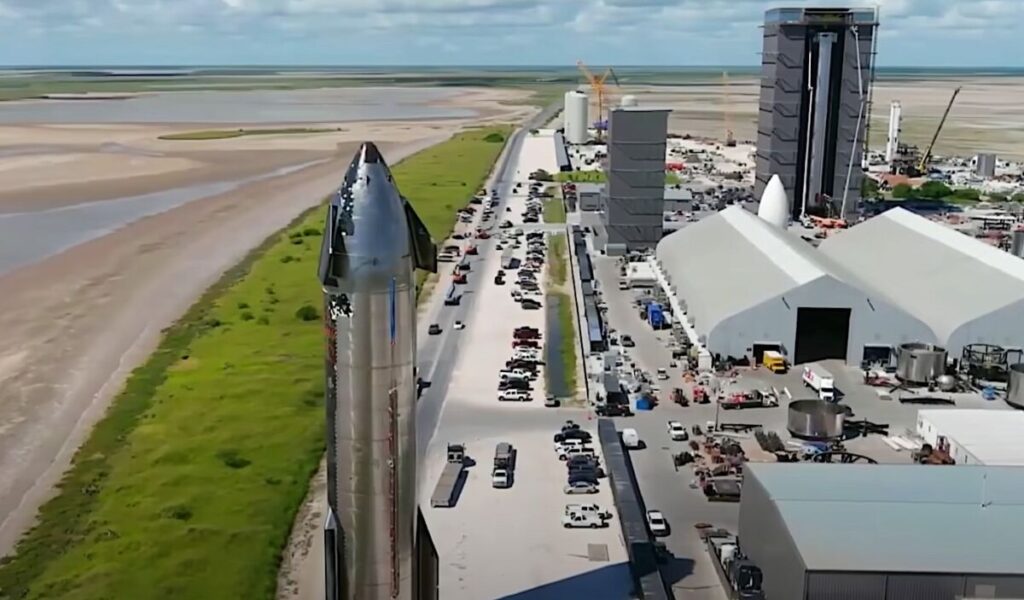
StarsBase Starship factory and launch pad at Texas - A complete rocket industry in one place!
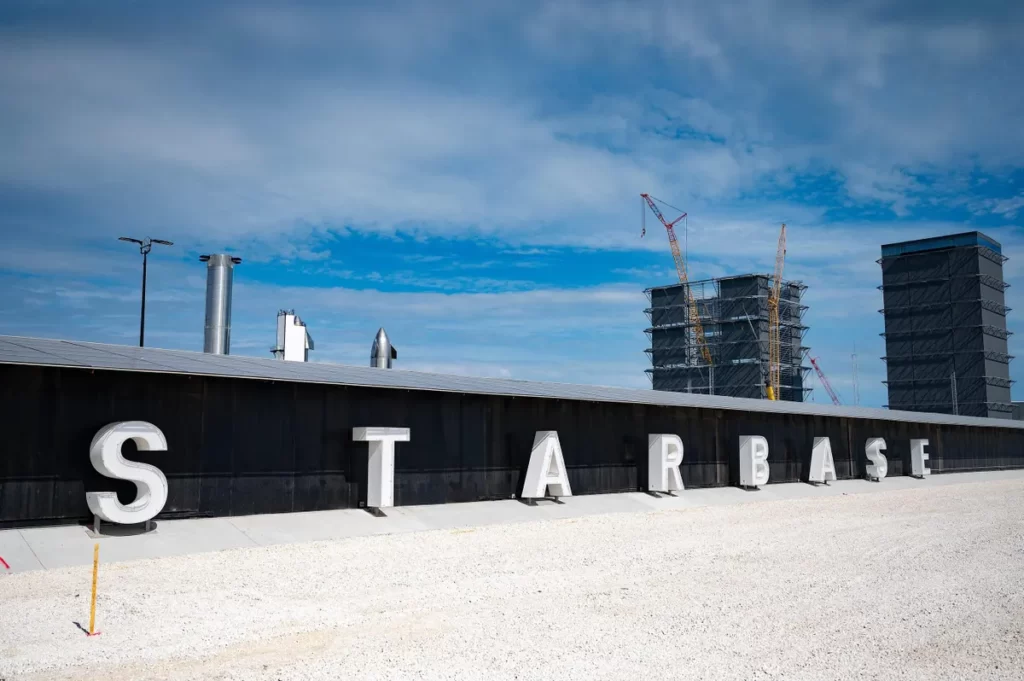
"Becoming Accustomed to" -Getting used to Phenomena.
This phenomenon reflects a new breed of behavior, marked by people and society acclimating themselves to a situation. When someone persistently reiterates concepts or ideas, regardless of their seriousness, gravity or authenticity, society tends to habitually overlook them. This inclination to dismiss can be referred to as ‘getting used to it.’
Elon Musk, the visionary behind SpaceX, serves as a prime example. He championed the concept of reusable rockets from the inception of SpaceX. Initially, many disregarded him as a tech enthusiast from the dot-com era. This dismissive attitude persisted each time he unveiled his visions of future technology. Over time, however, Musk began to turn these visions into reality. Falcon 1 was a success, followed by the triumphant launch of Falcon 9, (A vehicle with 9 engines, something unheard off at that time!). The unprecedented achievement of landing and reusing Falcon 9’s first stage further solidified his vision. To date, over 100 Falcon 9 first stages have been successfully reused.
In 2012, Musk boldly embarked on the colonization of Mars, introducing the Mars Colonial concept. In 2015, he reiterated his vision with the Big Falcon Rocket, later renamed Starship in 2016. From 2018 onwards, Starship construction commenced, culminating in its prototype’s inaugural flight in April 2023. Each time Elon presented an idea on Mars colonization, people dismissed his visions of future technology. Elon Musk moved on, and this is how we find ourselves in the current situation.
Remarkably, no space agency worldwide has fully embraced Musk’s challenge, except probably by China. Instead, people have grown accustomed to Musk’s futuristic proclamations, witnessing them materialize into reality. Now, space agencies and society have gotten to a point where all they can do is sit and watch on YouTube or live TV the attempts made by Elon Musk with the fully reusable rocket Starship.
Today Tesla is the number one electric car company in the world far far ahead of Toyota, Honda, Nissan, GM and German manufacturers.
Building rockets - SpaceX way!
SpaceX has revolutionized the way rockets are developed, employing an approach centered on iterative development and rapid prototyping. In contrast, the traditional development process, known as the WATERFALL MODEL, [REQUIRMENT-DESIGN – IMPLEMENT -TEST – MAINTAINANCE/SUPPORT] follows a structured sequence where requirements are meticulously studied, analyzed, and then solidified. Once frozen, the design phase commences, during which no new requirements can be introduced. After completing the design, the implementation phase begins, involving tasks like metal cutting, manufacturing, and prototyping. Testing – development flights follows implementation, where predefined performance metrics are assessed. Upon completing prototype testing, the project advances to the commercialization phase, encompassing production, maintenance, logistics, and operations.
This conventional method has been employed in the development of rockets such as the PSLV and GSLV, as well as aircraft like the HAL Tejas LCA in India. One notable drawback is the time span required for overall project development and implementation. Take the HAL Tejas, for example, conceived in the 1980s and 1990s with requirements from that era. However, due to the extended development period of over a decade, evolving NEW needs in military aviation arose. This misalignment poses a challenge within the confines of the waterfall method, assuming requirements are frozen and unchangeable. Although minor adjustments are feasible, major changes are not accommodated. Consequently, upon completion, the delivered product (LCA aircraft) may no longer meet the current demands of the Airforce. (Hence we are seeing LCA Mark 1A development again). This underscores the urgency in racing against time to adapt to ever-changing requirements.
This paradigm extends to rocketry, where failing to consider features like reusability during the requirement phase can lead to irreversibility. Recognizing superior elements or new inventions/discoveries during design or testing offers no avenue for their incorporation in the development due to frozen nature of requirements.
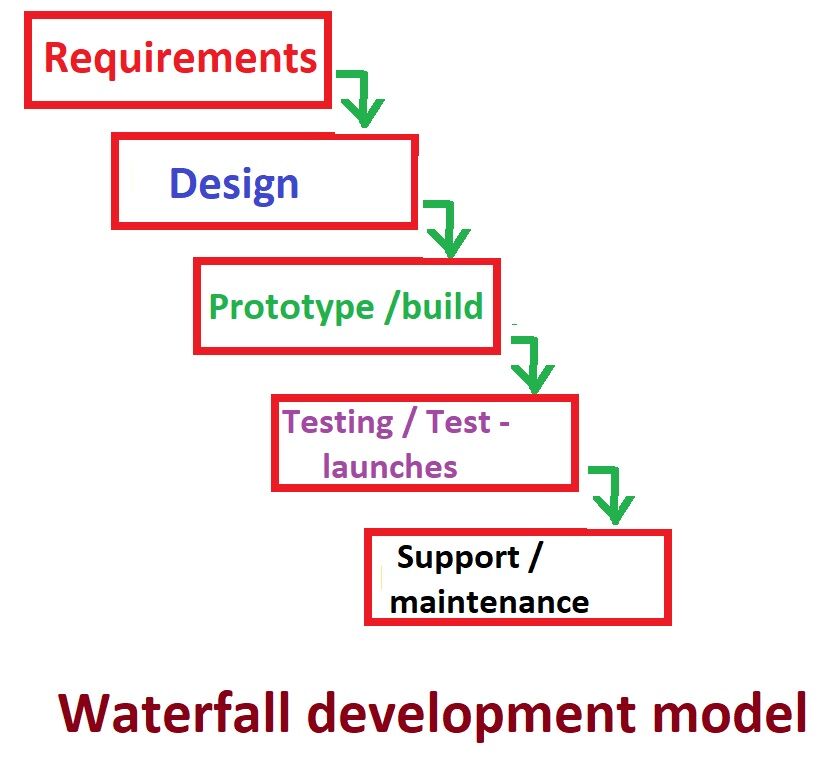
Rapid Prototyping and Iterative development
The iterative model focuses on incremental enhancements. This entails developers going through cycles of planning, design, coding, testing, and evaluation to refine the product or incorporate additional features. Regular releases facilitate the collection of feedback, leading to continuous improvements that align with the project requirements. Lessons learned in each cycle can be incorporated into requirement specifications or considered in design phase to make a better product.

The iterative development method, combined with rapid prototyping, constitutes the true cornerstone of SpaceX’s remarkable success in rocket development. By seamlessly integrating lessons learned from each testing cycle back into the requirements and design specifications, SpaceX ensures a continuous feedback loop. This iterative process consistently yields superior results with each successive development cycle, contributing significantly to their achievements.

A tangible illustration of the effectiveness of iterative development and rapid prototyping is evident in the image above. At the halfway mark of the project, two prototypes have already completed their testing cycles (Successful test or Failed test) under iterative development, whereas in the waterfall model, prototype construction might have only just commenced. This vividly demonstrates the potency of the iterative development approach. Not only does it expedite progress, but it also furnishes test results early on, which can be seamlessly integrated into the design process, fostering continuous improvement.
How SpaceX built reusable Falcon 9 rocket successfully!
Iterative Development and Rapid prototyping.
SpaceX followed an iterative development approach, continuously refining and improving their rocket designs. This allowed them to learn from each launch and implement necessary changes to enhance performance and reusability.
Vertical Integration:
SpaceX vertically integrated a significant portion of their manufacturing process, producing many of the rocket components in-house. This not only provided greater control over the quality and production timeline but also allowed for more rapid iteration.
SpaceX open to ideas. No matter how silly it sounds.
SpaceX has been known for its innovative and open-minded approach to rocket development. They have a culture of embracing unconventional and out-of-the-box ideas, no matter how unconventional or silly they may initially seem.
This spirit of innovation is evident in their current Starship development, particularly in their attempts to catch the second stage using a giant tower. As per Elon Musk, there are no landing legs on Starship returning form Space. Instead the giant tower will catch returning Super Heavy vehicles, using the chopsticks to support the boosters beneath their steering grid fins. Speaking on ideas like these can get an engineer fired in other companies, but not in SpaceX!
The Starship Dilemma Facing India!
Is it imperative for India to embark on the development of an Indian counterpart to Starship? The United States enjoys the luxury of not needing to do so, given that Starship itself is based there. However, the question arises: Is it a necessity for India? What could be the consequences of India refraining from such a program and potentially finding itself lagging behind in the future if it decides to pursue this path?” Wil it be too late if India delays decision making?
"Will India announce a competing rocket
or
Will India accept superiority of StarShip and do nothing!"
Chandrayaan 3 - grand Success! Next step should be manned mission to Moon, i.e, Indians landing on moon. Request PM to announce new rocket program @ ISRO that can take Indians to moon. Waiting for John F Kennedy moment from Modi! https://t.co/CBF0Lg8nnf https://t.co/PvvvhyRljs pic.twitter.com/JxSLUCSCb6
— Krishnamurthy Manjunatha (@MhboKrishna) August 27, 2023
At this juncture, and one could argue it’s already overdue, India faces the inescapable reality of SpaceX’s Starship. The critical question arises, which is also INDIAS’S STARSHIP DILEMMA! How will India respond? Will india embark on the development of a similar rocket, or will it acknowledge the technological supremacy of SpaceX’s Starship and do nothing! This question underscores India’s significant achievements and capabilities in space technology and exploration over the past several decades.
In very near future, India will have to answer this question: Should India develop a similar rocket to compete, or not? It’s essential to recognize that India possesses the means, financial resources, and technological expertise to develop a competitive rocket.
India has already achieved remarkable milestones, including successful lunar missions such as Chandrayaan 3 and robotic lander Vikram. It has demonstrated remote rover operations on the Moon, established a deep space network in Bangalore, mastered various rocket propulsion technologies (solid, liquid, hydrogen, and soon kerosene engines), and is on the cusp of sending its first Indian astronaut into low Earth orbit. India has also gained expertise in areas like heat shields, orbital reentry, descent, and landing using parachutes, and it has successfully sent spacecraft to Mars.
The technological base India has built over the past fifty years is nothing short of phenomenal. The question is, how long should India wait to take its next major step in space exploration and technology?
Challenges for development of Heavy Lift Rocket, capable of competing with Starship.
Developing a competitor to SpaceX’s Starship would present several significant challenges for India. Here are some of the key hurdles they would likely face:
Technological Innovation: Creating a spacecraft on par with Starship demands cutting-edge technology, from advanced materials for the heat shield to powerful engines for deep space travel.
Reusability and Reliability: Achieving full reusability is essential to reduce launch costs. Ensuring that components can be safely reused without compromising reliability is a major engineering feat.
Heavy Lift Capability: Starship is designed for massive payloads. ISRO would need to engineer a rocket capable of lifting substantial payloads to various orbits, including geostationary and beyond.
In-Orbit Refueling: Starship’s interplanetary capabilities hinge on in-orbit refueling. This technology would need to be developed and tested extensively.
Propulsion Systems: ISRO would need to design and build powerful engines capable of supporting missions to the Moon, Mars, and potentially beyond.
Testing and Prototyping: Iterative testing, similar to SpaceX’s Starship prototypes, is crucial for validating designs and identifying areas for improvement.
Adequate Funding: Developing a rocket of this scale demands significant financial resources. Securing the necessary funding would be a major challenge for ISRO.
Collaboration with Private Sector: Involving private companies in the development process, similar to SpaceX’s model, would require establishing effective partnerships and contractual frameworks.
Market Competition, Competing with SpaceX: Entering the commercial launch market with a new vehicle involves competing against established providers, which may require unique marketing strategies and pricing models.
Political and Geopolitical Considerations: Developing a rocket of this magnitude could have political and geopolitical implications, which may require careful navigation.
ISRO has a commendable track record of achieving ambitious goals, but developing a Starship competitor would be a monumental undertaking, necessitating a combination of innovation, resources, and strategic planning.
Budget
If technology development is not the primary concern, the next critical consideration becomes cost. Undoubtedly, the development of Starship comes with a hefty price tag. Elon Musk initially estimated it at around 5 billion US dollars, later suggesting it could rise to 10 billion US dollars. In contrast, the current budget of ISRO stands at approximately 1.5 billion US dollars.
From a financial perspective, should India decide to take the plunge, it has the capability to replicate what SpaceX is doing with Starship for significantly less capital. A feasible starting point could be initiating Starship-equivalent development, commencing from the financial year 2024, with an allocation of a few thousand crores. This approach offers numerous advantages.”
How much each test flight of Starship is costing SpaceX
Elon Musk has boldly asserted that the cost of a reusable Starship is projected to be a mere 10 million dollars. Even if this estimate were to be conservative and the final cost turned out to be around 50 million US dollars, it still represents a remarkably competitive pricing structure compared to other launch vehicles in the market. What’s more, in reusable mode, Starship is anticipated to carry an estimated payload of up to 100 tons to Low Earth Orbit (LEO), setting a new standard in cost-effectiveness and efficiency for space transportation.
New Generation Launch Vehicle Development - time to take a call?
The current launch vehicles at ISRO – PSLV, GSLV, LVM3 are non-reusable, a design paradigm that has served its purpose well since the 1990s. While functional, the primary concern lies in the cost per kilogram to orbit, which factors in the overall cost of each launch. This is a pivotal reason why the global trend is shifting towards reusable rockets. Elon Musk aptly illustrates this by drawing a parallel with commercial aviation – imagine if airplanes were disposed of after every flight. This is essentially the current state of rocketry, except for SpaceX’s Falcon 9 rockets.
Recognizing this, ISRO is poised to embark on the development of next-generation launch vehicles. However, if this initiative is funded by the government of India, it could face challenges in the American market due to the Commercial Space Launch Agreement (CSLA). In essence, the U.S. may not readily accept fair competition if the rocket is developed by another country with government funds or subsidies. While technically this may be considered an unfair practice, it nonetheless reflects the reality of an unlevel playing field.
Acknowledging this raises a valid concern – if such practices were to be accepted, it would pave the way for the Chinese government to heavily fund various new technologies, potentially gaining a dominant position in global markets. This underscores the complex dynamics at play in the realm of international space exploration and commerce.
India faces a dual challenge: navigating the influence of Starship and concurrently advancing NGLV rockets while safeguarding potential business opportunities with America. Fortunately, if both these problems are combined and addressed together, a solution appears. The solution lies in initiating the development of a reusable heavy-lift rocket at ISRO, a program that demands the creation of numerous cutting-edge technologies. Engaging private entities in this development process is crucial, allowing one or two selected players to spearhead the development of NGLV rockets, potentially positioning them as formidable competitors to the Falcon 9. By incorporating development costs within the heavy lift rocket program, we can effectively circumvent the potential repercussions of CLSA. This mirrors the approach employed by NASA with rocket developers. For instance, while a standard Falcon 9 rocket may be priced at 60 million US dollars for commercial customers, it is set at 100 million US dollars for government launches. This essentially amounts to an indirect subsidy transfer, representing a form of post-development funding.
Time duration needed
For any rocket developer, developing a rocket similar to SpaceX’s Starship is a highly complex and resource-intensive endeavor. The exact time duration needed for a competitor to achieve this would depend on a variety of factors, including the existing technological capabilities of the competitor, the level of financial investment, the availability of skilled personnel, and the overall development strategy. I would imagine anywhere form 5 to 10 years from project approval. Ten years may sound lot but one note that already over 5 years have been lost (including Covid 19)
Advantages for India in Heavy Lift Rocket Development
If India were to embark on the journey of building a Starship competitor, it would indeed have several distinct advantages:
Leveraging SpaceX’s Pioneering Work:
- ISRO can draw invaluable lessons and insights from SpaceX’s Starship development program. This includes studying their methodologies, technologies, and best practices, thus benefiting from SpaceX’s pioneering work.
Existing Example of Capacity and Capability:
- With Starship as a tangible example, ISRO has a clear benchmark in terms of capacity, capability, and technology utilization. This serves as a solid reference point for envisioning and developing its own spacecraft.
Learning from Starship’s Drawbacks:
- ISRO can critically evaluate Starship’s design and operation to identify potential drawbacks or areas for improvement. This offers an opportunity to apply innovative solutions and refine the spacecraft’s design for enhanced performance and safety.
Potential for Innovation and Advancements:
- ISRO’s engineers and scientists have a strong track record of innovation. By studying Starship and addressing its limitations, they can introduce novel technologies and design elements, potentially leading to a spacecraft that surpasses the capabilities of the original concept.
Tailoring to Specific Needs:
- ISRO can customize the spacecraft to cater to India’s specific space exploration goals, such as lunar missions, interplanetary travel, or other ambitious projects. This flexibility allows ISRO to prioritize areas of strategic importance.
Collaboration Opportunities:
- The development of a Starship competitor could pave the way for strategic collaborations, both domestically and internationally. ISRO could engage with private sector partners, research institutions, and other space agencies, fostering innovation and knowledge-sharing.
By capitalizing on these advantages and building upon the foundation laid by SpaceX’s Starship program, ISRO could potentially create a spacecraft that not only competes on a global scale but also addresses India’s unique space exploration objectives. This endeavor would represent a significant leap forward for India’s space program and its contributions to the broader field of space exploration.
Final Call rests with Prime Minister of India!
India’s pursuit of an alternate heavy-lift rocket akin to Starship hinges on a decision from the Prime Minister of India. Yet, any delay in this determination could curtail the potential benefits. The world has room for two heavy-lift rockets, but accommodating a third may prove challenging. Despite this, China is poised to make the attempt. However, its commercial success may face obstacles due to security apprehensions and China’s assertive approach.
“The fate of NASA’s SLS rocket appears bleak, with cost overruns and its non-reusability contributing to its premature demise. The speed at which this happens is contingent on the successful demonstration of SpaceX’s Starship. Europe faces challenges in its launch vehicle endeavors, as technical issues have forced the Vega rocket to take a backseat. The retirement of Ariane 5 was primarily a consequence of its inability to compete with SpaceX’s Falcon 9. Ariane 6 is nowhere near completion and expected to slip beyond 2024 to 2025 by the time, Starship may be up and flying around.
Russia still operates the Proton-M and Soyuz rockets, but the once-promising expendable Energia Rocket, which could have rivalled Starship, is no longer available. India watches these developments, while China has expressed intentions to emulate Starship, even though no prototypes have been publicly revealed. Japan, meanwhile, remains committed to its H2 rockets and shows no immediate aspirations for the development of a Starship competitor.”
How humanity came within striking distance of not one, but two rockets capable of transporting humans to the Moon or Mars, only to be decommissioned in 1970’s.
Indeed, humanity ventured closer to the realm of space travel with two remarkable rockets: the Soviet N1 and the American Saturn V. Regrettably, both of these pioneering rockets were retired within a decade of their development. The N1, after four launches, was on the cusp of demonstrating its prowess when it met an untimely end, marred by political rivalries among the project’s scientists or design architects. Perhaps most astonishing was the termination of the Saturn V program. Despite its resounding success (13 successful launches) and proven capabilities, it was last flown in 1973. Yes, Saturn V met an unexpected fate, despite being a perfectly functional and space-proven marvel.
N1 rocket got cancelled because it failed to reach orbit!
Saturn V rocket got cancelled, despite successfully reaching the moon!
This would come back to haunt America in the 2000s. The nation found itself in a predicament where it lacked any human-rated rockets capable of launching its own astronauts to the international space station after Space Shuttle retirement. Yes, the nation which went to moon in 1970s and nation which went to space in early 1960s had no means to go to space in 2011 all the way till SpaceX came out with crew dragon spacecraft. Between 2011 and 2020, Russian Soyuz was the sole means of human transport to the ISS, delivering long-term crew. America regained its foothold in space exploration with SpaceX’s Crew Dragon, which had its first flight to the ISS in November 2020. Without SpaceX’s Crew Dragon, America would have remained without a rocket capable of sending astronauts to the ISS.
